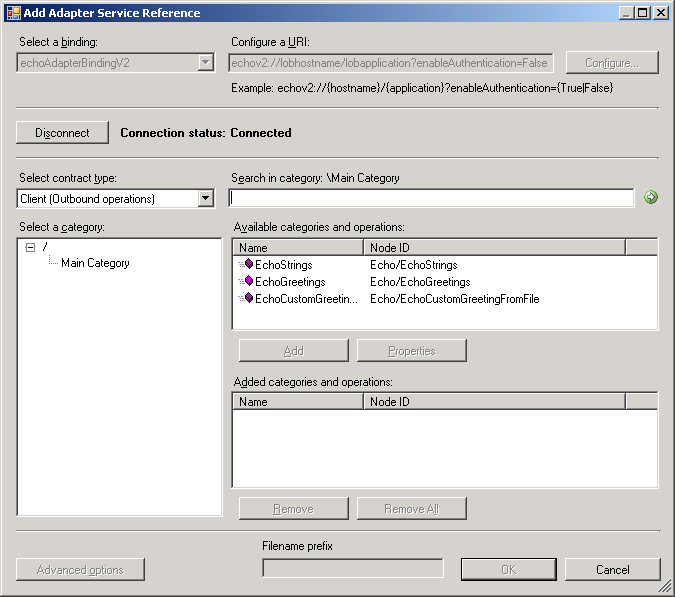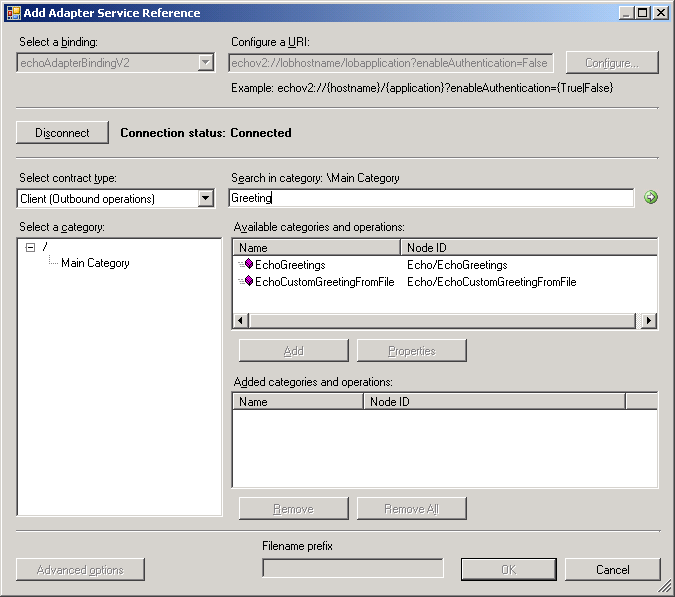使用 WCF LOB 配接器 SDK 流覽和搜尋中繼資料
本節提供如何藉由分別實作 IMetadataBrowseHandler 和 IMetadataSearchHandler 來公開流覽和搜尋功能的相關資訊。
IMetadataBrowseHandler
將配接器新增至專案時,IMetadataBrowseHandler 允許流覽配接器支援的類別和作業。 這可讓配接器取用者在設計階段檢視中繼資料資訊,並只選取用戶端進程所需的作業。
使用新增配接器服務參考 Visual Studio 外掛程式或取用配接器服務 BizTalk 專案增益集將配接器新增至專案時,IMetadataBrowseHandler 會填入 [選取合約類型]、 [選取類別] 和 [可用的類別和作業 ] 方塊。

下列範例示範如何實作 IMetadataBrowseHandler。 它會建構 MetadataRetrievalNode 陣列,其中包含配接器支援的類別和作業相關資訊。
public class EchoAdapterMetadataBrowseHandler : EchoAdapterHandlerBase, IMetadataBrowseHandler
{
/// <summary>
/// Initializes a new instance of the EchoAdapterMetadataBrowseHandler class
/// </summary>
public EchoAdapterMetadataBrowseHandler(EchoAdapterConnection connection
, MetadataLookup metadataLookup)
: base(connection, metadataLookup)
{
}
#region IMetadataBrowseHandler Members
/// <summary>
/// Retrieves an array of MetadataRetrievalNodes from the target system.
/// The browse operation will return nodes starting from the childStartIndex in the path provided in absoluteName, and the number of nodes returned is limited by maxChildNodes.
/// The method should complete within the specified timespan or throw a timeout exception.
/// If absoluteName is null or an empty string, return nodes starting from the root + childStartIndex.
/// If childStartIndex is zero, then return starting at the node indicated by absoluteName (or the root node if absoluteName is null or empty).
/// </summary>
public MetadataRetrievalNode[] Browse(string nodeId
, int childStartIndex
, int maxChildNodes, TimeSpan timeout)
{
// note we don't support timeout in this sample
if (MetadataRetrievalNode.Root.NodeId.Equals(nodeId))
{
MetadataRetrievalNode node = new MetadataRetrievalNode("EchoMainCategory");
node.DisplayName = "Main Category";
node.IsOperation = false;
node.Description = "This category contains inbound and outbound categories.";
node.Direction = MetadataRetrievalNodeDirections.Inbound | MetadataRetrievalNodeDirections.Outbound;
return new MetadataRetrievalNode[] { node };
}
else if( "EchoMainCategory".CompareTo(nodeId) == 0 )
{
// Inbound operations
MetadataRetrievalNode inOpNode1 = new MetadataRetrievalNode("Echo/OnReceiveEcho");
inOpNode1.DisplayName = "OnReceiveEcho";
inOpNode1.Description = "This operation echoes the location and length of a file dropped in the specified file system.";
inOpNode1.Direction = MetadataRetrievalNodeDirections.Inbound;
inOpNode1.IsOperation = true;
// Outbound operations
MetadataRetrievalNode outOpNode1 = new MetadataRetrievalNode("Echo/EchoStrings");
outOpNode1.DisplayName = "EchoStrings";
outOpNode1.Description = "This operation echoes the incoming string COUNT number of times in a string array.";
outOpNode1.Direction = MetadataRetrievalNodeDirections.Outbound;
outOpNode1.IsOperation = true;
MetadataRetrievalNode outOpNode2 = new MetadataRetrievalNode("Echo/EchoGreetings");
outOpNode2.DisplayName = "EchoGreetings";
outOpNode2.Description = "This operation echoes the incoming Greeting object COUNT number of times in an array of type Greeting.";
outOpNode2.Direction = MetadataRetrievalNodeDirections.Outbound;
outOpNode2.IsOperation = true;
MetadataRetrievalNode outOpNode3 = new MetadataRetrievalNode("Echo/EchoCustomGreetingFromFile");
outOpNode3.DisplayName = "EchoCustomGreetingFromFile";
outOpNode3.Description = "This operation echoes the greeting object by reading its instance from a file. The Greeting object's metadata is obtained from a predefined XSD file.";
outOpNode3.Direction = MetadataRetrievalNodeDirections.Outbound;
outOpNode3.IsOperation = true;
return new MetadataRetrievalNode[] { inOpNode1, outOpNode1, outOpNode2, outOpNode3 };
}
return null;
}
#endregion IMetadataBrowseHandler Members
}
IMetadataSearchHandler
在配接器內實作 IMetadataSearchHandler 可讓您藉由輸入搜尋字詞,例如作業名稱的一部分,在設計階段搜尋可用的作業。 如果您的配接器包含許多作業,這非常有用,因為您可以輸入搜尋值來限制傳回的作業。
使用 [新增配接器服務參考 Visual Studio 外掛程式] 或 [取用配接器服務 BizTalk 專案增益集] 將配接器新增至專案時,IMetadataSearchHandler 會解析在 [在類別中搜尋 ] 方塊中輸入的搜尋字串,並傳回 [可用類別和作業 ] 方塊中的相符專案清單。

您也可以在產生配接器的 WSDL 或 Proxy 時,使用 svcutil.exe 來執行搜尋,方法是以 op=value 格式將搜尋值當做查詢字串傳遞。 以下是使用 svcutil.exe 只傳回 Echo/EchoStrings 作業資訊的範例。
svcutil.exe “echov2://lobhostname/lobapplication?enableAuthentication=False&op=Echo/EchoStrings” /target:metadata
注意
WCF LOB 配接器 SDK 不提供預設萬用字元搜尋功能,例如 Echo* 或 %Echo%。 配接器作者可實作萬用字元或模式比對功能。
下列範例示範如何實作 IMetadataSearchHandler。 它會建構 MetadataRetrievalNode 陣列,其中包含配接器支援的類別和作業相關資訊。
public class EchoAdapterMetadataSearchHandler : EchoAdapterHandlerBase, IMetadataSearchHandler
{
/// <summary>
/// Initializes a new instance of the EchoAdapterMetadataSearchHandler class
/// </summary>
public EchoAdapterMetadataSearchHandler(EchoAdapterConnection connection
, MetadataLookup metadataLookup)
: base(connection, metadataLookup)
{
}
#region IMetadataSearchHandler Members
/// <summary>
/// Retrieves an array of MetadataRetrievalNodes (see Microsoft.ServiceModel.Channels) from the target system.
/// The search will begin at the path provided in absoluteName, which points to a location in the tree of metadata nodes.
/// The contents of the array are filtered by SearchCriteria and the number of nodes returned is limited by maxChildNodes.
/// The method should complete within the specified timespan or throw a timeout exception. If absoluteName is null or an empty string, return nodes starting from the root.
/// If SearchCriteria is null or an empty string, return all nodes.
/// </summary>
public MetadataRetrievalNode[] Search(string nodeId
, string searchCriteria
, int maxChildNodes, TimeSpan timeout)
{
List<MetadataRetrievalNode> resultList = new List<MetadataRetrievalNode>();
if ("OnReceiveEcho".ToLower().Contains(searchCriteria.ToLower()))
{
MetadataRetrievalNode nodeInbound = new MetadataRetrievalNode("Echo/OnReceiveEcho");
nodeInbound.DisplayName = "OnReceiveEcho";
nodeInbound.Description = "This operation echos the location and length of a file dropped in the specified file system.";
nodeInbound.Direction = MetadataRetrievalNodeDirections.Inbound;
nodeInbound.IsOperation = true;
resultList.Add(nodeInbound);
}
if ("EchoStrings".ToLower().Contains(searchCriteria.ToLower()))
{
MetadataRetrievalNode outOpNode1 = new MetadataRetrievalNode("Echo/EchoStrings");
outOpNode1.DisplayName = "EchoStrings";
outOpNode1.Description = "This operation echoes the incoming string COUNT number of times in a string array.";
outOpNode1.Direction = MetadataRetrievalNodeDirections.Outbound;
outOpNode1.IsOperation = true;
resultList.Add(outOpNode1);
}
if ("EchoGreetings".ToLower().Contains(searchCriteria.ToLower()))
{
MetadataRetrievalNode outOpNode2 = new MetadataRetrievalNode("Echo/EchoGreetings");
outOpNode2.DisplayName = "EchoGreetings";
outOpNode2.Description = "This operation echoes the incoming Greeting object COUNT number of times in an array of type Greeting.";
outOpNode2.Direction = MetadataRetrievalNodeDirections.Outbound;
outOpNode2.IsOperation = true;
resultList.Add(outOpNode2);
}
if ("EchoCustomGreetingFromFile".ToLower().Contains(searchCriteria.ToLower()))
{
MetadataRetrievalNode outOpNode3 = new MetadataRetrievalNode("Echo/EchoCustomGreetingFromFile");
outOpNode3.DisplayName = "EchoCustomGreetingFromFile";
outOpNode3.Description = "This operation echoes the greeting object by reading its instance from a file. The Greeting object's metadata is obtained from a predefined XSD file.";
outOpNode3.Direction = MetadataRetrievalNodeDirections.Outbound;
outOpNode3.IsOperation = true;
resultList.Add(outOpNode3);
}
return resultList.ToArray();
}
#endregion IMetadataSearchHandler Members
}